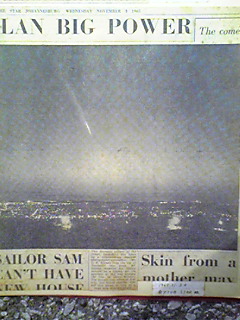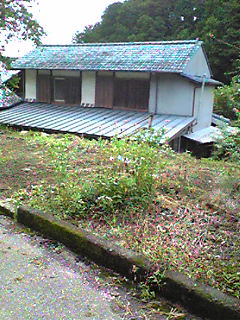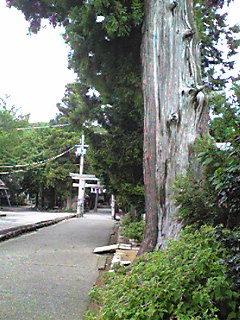September 19, 2009
Every year, when mid-September comes around, I strongly sense
the arrival of the time when Kreutz group comets appear. The comet, which
had shaken the world of comet observers, arrived from the sky east of Canis
Major. This morning, I was not particularly conscious of this comet, but
the eyepiece field of my 15cm binoculars was fixed in the pre-dawn southeastern
sky. The discovery of this comet took place on the morning of September
19, 1965, right at the point where the two lines crossed over: a line running
through Alpha and Beta CMa and extended east; the other through Alpha and
Beta Gem extended also eastward. This means that, in any year on September
19, Kreutz group comets always appear at this point. It was amazing that
French astronomer Dr. Roger Rigollet determined this comet to be a Kreutz
only by looking at the telegram reporting the discovery position of this
comet and even predicted and proved correct the perihelion date of October
21. Furthermore, the Smithsonian released their early prediction to mass
media that this comet would become the greatest comet of the 20th century.
While searching the sky, I was keenly aware that the sky
over Kochi in 1965 had been far better than the sky over Geisei today.
The day of the discovery was immediately after the passing of a typhoon,
and in spite of a waning moon, the sky was extraordinarily transparent.
The comet's magnitude was 8, but it was close to the limit of the 88mm
refractor. I was wondering while searching if the 15cm binoculars could
have discovered the same comet.
The search lasted for one hour from 3.30 am to 4.30 am. The
pre-dawn sky wasn't perfect with Moon and Venus shining side by side and
the zodiacal light glowing. I thought that it would be difficult to discover
even a 9th-magnitude comet.
The 88mm telescope used for this discovery provided excellent focusing, while the 15cm binoculars showed an equally sharp and pleasingly bright field. I searched with the Navigator (digital setting circles). This device is not perfect with somewhat fast battery consumption and a wire from a small square battery holder tending to break off (broken solder). Without a spare battery holder, you would certainly panic. In spite of this, I find this device most useful to determine the position of a target in a twilight sky with few stars visible. Many decades ago, Mr. Minoru Honda at Kurashiki Observatory continued to search eagerly until the sky turned pale in a quite bright morning twilight. His extraordinary effort and experience made up for the Achilles heel of the alt-azimuth mount in the days without a Navigator. Accomplished skills and experience are very valuable and acquired only by those dedicated observers.

Comet Ikeya-Seki seen over Johannesburg
as shown in South African newspaper the
Star dated November 3, 1965
(This comet was best viewed from the Southern Hemisphere)
September 12, 2009
I left the pathway leading to the national treasure Asakura
Shrine. I walked across JR's railroad crossing, then came to a road along
a little stream. I often used this old road in my childhood. By walking
for about one kilometer along this stream at the foot of Akaoniyama mountain,
I should be able to reach my father's family home at Nakanotani. In old
days it was a quiet village where waterwheels were turning and numerous
fireflies were flying around in summer. But today, the gigantic bridge
girders of an expressway imposingly stretched over the road ahead of me
as if it were straddling the little village in a valley. I managed to get
a general direction of my father's family home by asking an elderly local
woman under the girders of the bridge. The village has completely changed
its appearance with many modern buildings and facilities having been built
over a period of more than half a century. My relative's house was partially
rebuilt leaving no trace of the house I was familiar with, but the two-story
house where I had lived during the war was still standing untouched.

The house where we stayed for 3 month around the end of the war
In my junior high school days, I was indifferent to astronomy;
instead I loved radios. At our home in Kamimachi, I took a crystal radio
set into the air raid shelter in the courtyard to gather information to
be prepared for daily air raids. When we were evacuated to the countryside,
I built a shortwave radio which could pick up broadcast from overseas and
listened secretly to broadcasts directed toward Japan. The government strictly
banned listening to short wave radio broadcasts from overseas. But, unlike
many deceptive announcements broadcast by the Imperial Headquarters, we
were able to know the real war situation. It was banned because the government
was concerned that, if many Japanese realized Japan was losing the war,
their morale for fighting would be lost. In and around the city, we felt
the piercing eyes of special political police and military police. If you
were found to be violating this restriction, you would be imprisoned without
mercy. My curiosity for knowing the truth about the war situation made
me take a difficult and dangerous daring step toward building a shortwave
radio.
There was a long-established radio store called Saizensha
near our home in Kamimachi. I frequently visited the store to buy parts
to build radios. To receive shortwave broadcast, there was a secret in
winding a tuning coil to syntonize to shortwave frequencies. After several
unsuccessful attempts, I finally heard overseas broadcast mixed with beeping
signals. I jumped up and down with excitement.
"Hello, Japanese people. Today, we will bring you nostalgic
tango music and also let you know the current war situation." The
broadcast like this came frequently from the U.S.A. and enemy countries
in the south. I heard in secret the fatal news of Japan's acceptance of
the Potsdam Declaration in the upstairs of our evacuation home. I picked
up the news of Japan's defeat ahead of anybody else, but at the same time
I also heard the tragic news that one of my cousins of the family we had
lived with was killed in action in the south. The news shocked me. I was
saddened immensely.
While I was looking up at the upstairs of our old evacuation
home, I found a single red spider lily flowering at my feet on the side
of a lane. There used to be a fountain here with crystal clear water running.
A wooden bucket to store water was placed nearby together with a ladle.
The sight of these brought back the memories of the days when I used to
play having a drink of water from the bucket with the cousin killed in
the war. I instinctively prayed to that single flower joining my hands
together.

A little creek running at the foot of Akaoniyama mountain
September 3, 2009
We didn't feel like returning to our home in war-devastated
Kamimachi even after August 15, the day the war ended. Instead, we decided
to remain at my father's hometown for a while. A long spell of good weather
continued into September and magnificent starry skies spread overhead every
night. After the war ended, I went to school walking for about 10 kilometers.
Public transportation was completely paralyzed, as trains and buses had
been destroyed in air raids.
It was at midnight of the day before the end of the war that
I heard a roaring sound of B-29s. My father, looking at the sky in the
yard, shouted loudly, "Damn! They dropped it here!" He said something
had flashed in the air. then, I began to hear a typical zipping sound of
bombs. I ducked but didn't know what to do. Then, I heard in the direction
of the mountain a loud reverberating "clank". I thought it was
funny; it wasn't like a bomb. The following morning, I went out to check
it out and found white sheets of paper scattered all over on the side of
the mountain north of our house. When I tried to pick one up, my father
shouted, "Look out! It will blow up!" They weren't bombs; they
were just leaflets.
It began with: "To Japanese people. We have not come
today to drop bombs. We would like to make an announcement on the terms
of surrender that your government has requested..." and continued
endlessly in difficult Japanese that the Japanese government had accepted
the Potsdam Declaration resulting in Japan's unconditional surrender. They
dropped the leaflets aiming at the center of Kochi City, but overshot it
and they landed in our little village northwest of the city. We didn't
believe what was written thinking it was an enemy propaganda, but it turned
out to be real as we heard the radio broadcast declaring the end of the
war the following day. The first full moon night in September was beautiful
and crystal clear. I kept walking completely lost in thought. I was 15
years old. I walked on with anxieties and hopes for a new era crisscrossing
in my mind .
I could not forget the period of time I had spent in my hometown
before and after the end of the war. I had fond memories of those years
and could not resist the urge to visit there again. I followed the route
my father often took to commute on his bicycle during the war. Asakura
Shrine was near JR Asakura station and my father used to enter the shrine's
compound and rode his bike northward. The shrine was still there. My father
called this shrine "kinomaru-sama". In old days an enshrined
rock was placed on a well-built table in front of the shrine. I hope it
could be a meteorite, but could not find anything like that. I was amazed
at giant sugi (Japan cedar) along the pathway to the shrine. It would probably
be at least 1000 years old. When I walked along the fairly long pathway
lined with magnificent cedars, the shrine came into view. On the wall of
the shrine was a large fine painting depicting a Chinese landscape. When
I was a little child, I walked along this pathway with my father many times
to go to his hometown. "Can I find our home there?" Holding some
apprehension, I stopped to pray at the shrine and began to walk relying
on my childhood memory.

The shrine's pathway lined with ancient giant Japan cedars

The shrine with rare paintings





